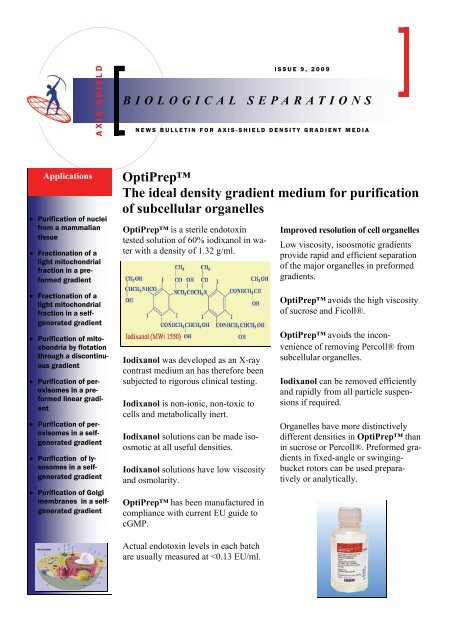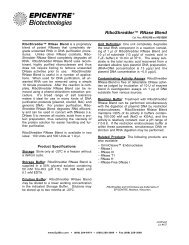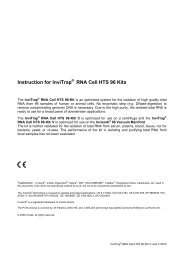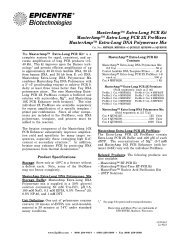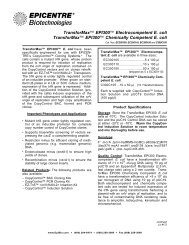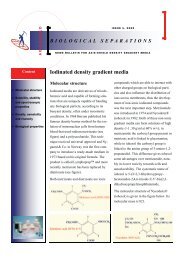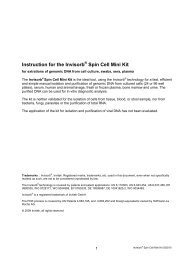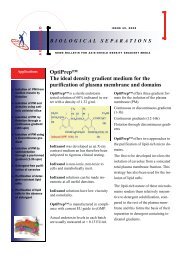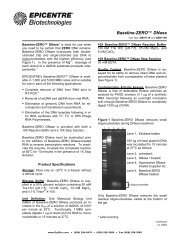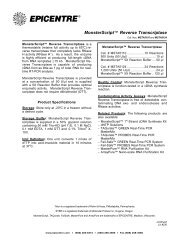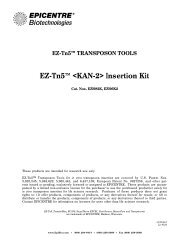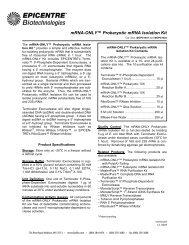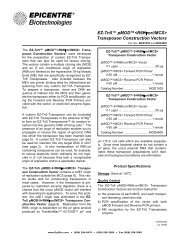OptiPrep™ The ideal density gradient medium for purification of ...
OptiPrep™ The ideal density gradient medium for purification of ...
OptiPrep™ The ideal density gradient medium for purification of ...
Create successful ePaper yourself
Turn your PDF publications into a flip-book with our unique Google optimized e-Paper software.
AXIS-SHIELD<br />
ISSUE 9, 2009<br />
BIOLOGICAL SEPARATIONS<br />
NEWS BULLETIN FOR AXIS-SHIELD DENSITY GRADIENT MEDIA<br />
Applications<br />
• Purification <strong>of</strong> nuclei<br />
from a mammalian<br />
tissue<br />
• Fractionation <strong>of</strong> a<br />
light mitochondrial<br />
fraction in a pre<strong>for</strong>med<br />
<strong>gradient</strong><br />
OptiPrep<br />
<strong>The</strong> <strong>ideal</strong> <strong>density</strong> <strong>gradient</strong> <strong>medium</strong> <strong>for</strong> <strong>purification</strong><br />
<strong>of</strong> subcellular organelles<br />
OptiPrep is a sterile endotoxin<br />
tested solution <strong>of</strong> 60% iodixanol in water<br />
with a <strong>density</strong> <strong>of</strong> 1.32 g/ml.<br />
Improved resolution <strong>of</strong> cell organelles<br />
Low viscosity, isoosmotic <strong>gradient</strong>s<br />
provide rapid and efficient separation<br />
<strong>of</strong> the major organelles in pre<strong>for</strong>med<br />
<strong>gradient</strong>s.<br />
• Fractionation <strong>of</strong> a<br />
light mitochondrial<br />
fraction in a selfgenerated<br />
<strong>gradient</strong><br />
• Purification <strong>of</strong> mitochondria<br />
by flotation<br />
through a discontinuous<br />
<strong>gradient</strong><br />
• Purification <strong>of</strong> peroxisomes<br />
in a pre<strong>for</strong>med<br />
linear <strong>gradient</strong><br />
• Purification <strong>of</strong> peroxisomes<br />
in a selfgenerated<br />
<strong>gradient</strong><br />
• Purification <strong>of</strong> lysosomes<br />
in a selfgenerated<br />
<strong>gradient</strong><br />
• Purification <strong>of</strong> Golgi<br />
membranes in a selfgenerated<br />
<strong>gradient</strong><br />
Iodixanol was developed as an X-ray<br />
contrast <strong>medium</strong> an has there<strong>for</strong>e been<br />
subjected to rigorous clinical testing.<br />
Iodixanol is non-ionic, non-toxic to<br />
cells and metabolically inert.<br />
Iodixanol solutions can be made isoosmotic<br />
at all useful densities.<br />
Iodixanol solutions have low viscosity<br />
and osmolarity.<br />
OptiPrep has been manufactured in<br />
compliance with current EU guide to<br />
cGMP.<br />
Actual endotoxin levels in each batch<br />
are usually measured at
BIOLOGICAL SEPARATIONS<br />
Page 2<br />
Purification <strong>of</strong> nuclei from mammalian tissue or a cell homogenate<br />
<strong>The</strong> preparation <strong>of</strong> intact nuclei must be carried out in<br />
an environment which causes the least possible disruption<br />
<strong>of</strong> the nucleoprotein complexes within them. Sucrose<br />
solutions are not dense enough to band nuclei and<br />
although both CsCl and diatrizoate can provide solutions<br />
<strong>of</strong> sufficient <strong>density</strong>, their ionic strength causes disruption<br />
<strong>of</strong> the nucleoprotein structure unless the chromatin<br />
is first fixed using a cross-linking agent, such as <strong>for</strong>maldehyde,<br />
to prevent dissociation <strong>of</strong> the protein from the<br />
DNA. Thus the routine method <strong>for</strong> purifying nuclei involves<br />
pelleting them through 60% sucrose at 100,000g<br />
<strong>for</strong> 1-2 h.<br />
Using OptiPrep it is now possible to band nuclei<br />
isopycnically in an environment which optimizes the<br />
retention <strong>of</strong> the native state <strong>of</strong> the organelle.<br />
Because <strong>of</strong> the mush lower viscosity <strong>of</strong> the OptiPrep<br />
solution required,<br />
the <strong>purification</strong><br />
process can be carried<br />
out in much<br />
lower g-<strong>for</strong>ce <strong>for</strong><br />
shorter time;<br />
10,000g <strong>for</strong> 20 min.<br />
Because <strong>of</strong> the<br />
much lower osmolality <strong>of</strong> the iodixanol solutions used<br />
to isolate nuclei (compared to those <strong>of</strong> sucrose) the <strong>density</strong><br />
<strong>of</strong> the nuclei is also much lower (approx 1.20 g/ml<br />
versus >1.32 g/ml). <strong>The</strong> figure shows the separation <strong>of</strong><br />
nuclei from mammalian liver using OptiPrep.<br />
For protocol and references see S08 on the Opti-<br />
Prep Application CD or online at: www.axisshield-<strong>density</strong>-<strong>gradient</strong>-media.com<br />
Fractionation <strong>of</strong> a light mitochondrial fraction in a pre-<strong>for</strong>med <strong>gradient</strong><br />
OptiPrep <strong>gradient</strong>s can be used to resolve the subcellular<br />
organelles (Golgi membranes, lysosomes, mitochondria,<br />
peroxisomes) from a light mitochondrial fraction.<br />
Because <strong>of</strong> their lower osmolality and viscosity,<br />
the iodinated <strong>density</strong> <strong>gradient</strong> media provide improved<br />
resolution and, using pre<strong>for</strong>med <strong>gradient</strong>s, reduced centrifugation<br />
times, compared to standard sucrose <strong>gradient</strong>s.<br />
Unlike separations in Percoll®, it is not necessary to pre-<strong>for</strong>med 10-30% (w/v) iodixanol <strong>gradient</strong> in a<br />
remove the <strong>medium</strong> to be able to per<strong>for</strong>m standard spectrophotometric<br />
enzyme assays or SDS-PAGE on gradi-<br />
For a detailed protocol and references see S13 on the<br />
swinging-bucket rotor. <strong>The</strong> sample was bottom loaded .<br />
ent fractions. <strong>The</strong> figure shows the fractionation <strong>of</strong> a OptiPrep Application CD or online at: www.axisshield-<strong>density</strong>-<strong>gradient</strong>-media.com<br />
light mitochondrial fraction, from mammalian liver, in a<br />
Fractionation <strong>of</strong> peroxisomes in a self-generated <strong>gradient</strong><br />
An option <strong>for</strong> the <strong>purification</strong> <strong>of</strong> peroxisomes is the use<br />
<strong>of</strong> a self-generated <strong>gradient</strong>. <strong>The</strong> optimal manner <strong>of</strong> producing<br />
useful self-generated <strong>gradient</strong>s is to use approx<br />
365,000g av <strong>for</strong> approx 3 h in a near-vertical or vertical<br />
rotor. Under these conditions <strong>gradient</strong>s that are more or<br />
less linear can be produced. Such a high g-<strong>for</strong>ce may be<br />
considered unattractive <strong>for</strong> the recovery <strong>of</strong> good organelle<br />
function and structure. However the <strong>gradient</strong> shape<br />
that is required <strong>for</strong> the separation <strong>of</strong> peroxisomes from<br />
the less dense organelles <strong>of</strong> a light mitochondrial
ISSUE 9, 2009<br />
Page 3<br />
fraction is an S-shaped one (see figure), which is shallow<br />
in the middle. To achieve such a <strong>density</strong> pr<strong>of</strong>ile, the<br />
g-<strong>for</strong>ce required can be reduced to 180,000g and there<br />
is a less strict requirement <strong>for</strong> a near vertical or vertical<br />
rotor, so many fixed-angle rotors are suitable. Selfgenerated<br />
<strong>gradient</strong>s have been used <strong>for</strong> rat liver and<br />
human hepatoblastoma cells ; He et al were able to use<br />
a Beckman 50.2 Ti fixed-angle rotor – a rotor that<br />
would be totally unsuitable <strong>for</strong> creation <strong>of</strong> linear <strong>gradient</strong>s.<br />
For a detailed protocol and references see S11 on the<br />
OptiPrep Application CD .<br />
Purification <strong>of</strong> mammalian lysosomes in a self-generated <strong>gradient</strong><br />
Mammalian lysosomes have generally been isolated in<br />
continuous pre-<strong>for</strong>med <strong>gradient</strong>s <strong>of</strong> iodixanol and the<br />
basic technique <strong>of</strong> underlayering a 10-30% or 19-27%<br />
(w/v) iodixanol <strong>gradient</strong> with the light mitochondrial<br />
fraction is a good starting point from which many protocols<br />
have been developed.<br />
Another popular strategy is to use a self-generated <strong>gradient</strong>;<br />
this was first developed <strong>for</strong> mouse liver. <strong>The</strong><br />
crude mitochondrial fraction is adjusted to 20% (w/v)<br />
iodixanol and centrifuged at 180,000g <strong>for</strong> 3 h ; a typical<br />
result is shown in the figure.<br />
For a detailed protocol and references see S14 on the<br />
OptiPrep Application CD or online at: www-axisshield-<strong>density</strong>-<strong>gradient</strong><br />
media.com<br />
Purification <strong>of</strong> mitochondria using a discontinuous <strong>gradient</strong><br />
Nycodenz® has been widely used as a <strong>density</strong> <strong>gradient</strong><br />
<strong>medium</strong> <strong>for</strong> the isolation <strong>of</strong> pure mitochondria from<br />
yeast since methods were first published by Glick and<br />
Pon. Commonly a crude mitochondrial pellet is layered<br />
on top <strong>of</strong> 14.5% and 18% (w/v) Nycodenz® in buffered<br />
0.6 M sorbitol; after 30 min at approx 120,000g, the<br />
mitochondria band at the 14.5%/18% Nycodenz® interface.<br />
With OptiPrep a flotation strategy through a discontinuous<br />
<strong>gradient</strong> has been used (see figure). Yeast mitochondria<br />
have also been purified (from a light mitochondrial<br />
pellet) by sedimentation through a pre<strong>for</strong>med<br />
continuous 0-25% (w/v) iodixanol <strong>gradient</strong> at<br />
10-12,000g <strong>for</strong> 2 h. In this protocol, which has been<br />
been used to study iron metabolism in yeast, the mitochondria<br />
band in the bottom third <strong>of</strong> the <strong>gradient</strong>, separated<br />
from the lighter prevacuole and vacuole.<br />
For detailed protocols using iodixanol see S12 and<br />
S15 on the OptiPrep Applications CD or online at:<br />
www.axis-shield-<strong>density</strong>-<strong>gradient</strong>-media.com
Web:<br />
www.axis-shield-<strong>density</strong>-<strong>gradient</strong>media.com<br />
In this leaflet we have presented some <strong>of</strong> the applications<br />
available <strong>for</strong> the isolation <strong>of</strong> cell organelles using<br />
OptiPrep. More in<strong>for</strong>mation can be found on: www.axis<br />
-shield-<strong>density</strong>-<strong>gradient</strong>-media.com. On the front page<br />
click on “Subcellular membranes and cell organelles”.<br />
AXIS-SHIELD<br />
PO Box 6863 Rodelokka<br />
N-0504 Oslo<br />
Norway<br />
Phone: +47 24 05 60 00<br />
Fax: +47 24 05 60 10<br />
Email: bjh@no.axis-shield.com or<br />
Ficoll and Percoll are trademarks <strong>of</strong> GE Healthcare companies<br />
john@jgrescon.fsbusiness.co.uk<br />
Fractionation <strong>of</strong> Golgi in a self-generated <strong>gradient</strong><br />
Whether the light mitochondrial fraction is used to prepare<br />
Golgi membranes depends on their response to<br />
homogenization; if they vesiculate they will be recovered<br />
in the microsomal fraction; if they retain a tubular<br />
structure they will be recovered in the light mitochondrial<br />
fraction. <strong>The</strong>y are the least dense membrane in the<br />
light mitochondrial fraction and can be effectively isolated<br />
in a self-generated OptiPrep <strong>gradient</strong> (see figure).<br />
Pre-<strong>for</strong>med <strong>gradient</strong> may also be used. Note that the<br />
isolation <strong>of</strong> Golgi membrane vesicles and other components<br />
<strong>of</strong> the secretory endocytic and synthetic systems<br />
are described elsewhere.<br />
For a detailed protocol and references see S14 on the<br />
OptiPrep Application CD or online at: www.axisshield-<strong>density</strong>-<strong>gradient</strong>-media.com


